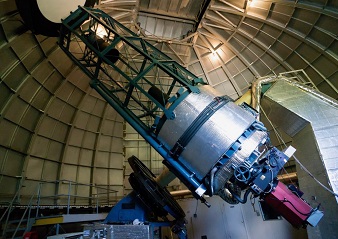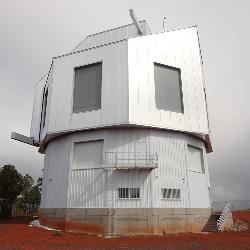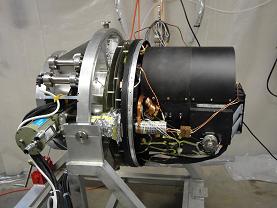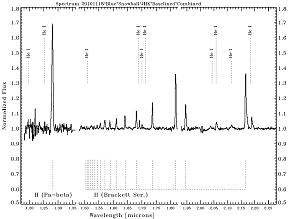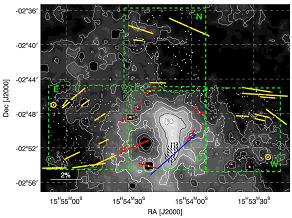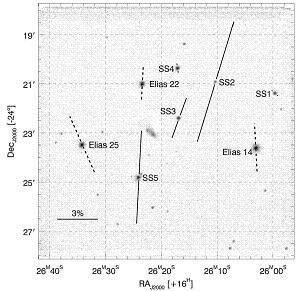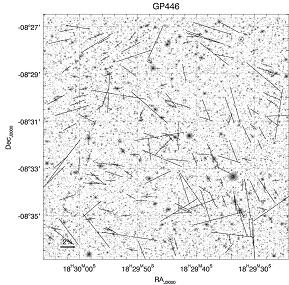Emeritus Professor Dan Clemens
Department of Astronomy, and
Institute for Astrophysical Research,
Boston University
College of Arts and Sciences Building
725 Commonwealth Avenue
Boston, Massachusetts 02215
Office Ph: (617) 353-6140
email: 'clemens at bu.edu'

Current Course(s): 2024-2025 year
none
Note to potential students:
I am in retirement and no longer taking on research mentees. Sorry!
Please consider contacting other faculty members in the department for a suitable research group match.
Since June 2019, Boston University has been the sole owner and operator of the Perkins Telescope Observatory (PTO) on Anderson Mesa, outside Flagstaff, Arizona. Mimir and its optical wavelength twin instrument PRISM (shown here) are the two facility-class light analysis tools on the PTO.
At Left: Dan Clemens and Dr. Marc Buie during 2004 commissioning of the Mimir instrument on the Perkins Telescope (now operated by Boston University, located outside Flagstaff, AZ).
Current Research Projects & Areas:
I have worked primarily on problems of Galactic astrophysics, including star formation, Galactic structure, and the interstellar medium. One large effort mapped the magnetic field in the star-forming molecular gas clouds in the disk of the Milky Way through use of the Mimir instrument to conduct the Galactic Plane Infrared Polarization Survey (GPIPS). This Survey used the weak (1-2%) linearly polarization signal impressed on unpolarized background starlight by foreground dust grains spinning about the magnetic fields present in the gas and dust clouds to reveal the plane of sky orientation of the field. GPIPS completed its observations phase on the Perkins telescope in Arizona in June 2020 and the full data products (images, catalogs) were released to the community in an updated form (DR4) in August 2020. The roughly 1 million stellar polarizations measured represent many orders of magnitude improvement in the number of probes of the magnetic field in the Galaxy.
A somewhat organized list of my recent and past activities include:
- The Mimir Instrument - a near-infrared wide-field imaging polarimeter and spectrometer facility-class instrument on the 1.8m Perkins telescope.
- "Mimir: A Near-Infrared Wide-Field Imager, Spectrometer, and Polarimeter", Clemens, D. P., et al. 2007, PASP, 119, 1385
- The Galactic Plane Infrared Polarization Survey (GPIPS) - an H-band imaging polarization survey of 76 sq deg of the first Galactic Quadrant
- GPIPS Web site - info and access to released data (also hosted at the Infrared Science Archive [IRSA])
- GPIPS Introduction Paper (Clemens et al., 2012a, ApJS, 200, 19)
- GPIPS Calibration Paper (Clemens et al., 2012b, ApJS, 200, 20)
- GPIPS First Data Release Paper (Clemens et al. 2012c, ApJs, 200, 21)
- GPIPS Data Release 4 (Clemens et al., 2020, ApJS, 249, 23)
- Past Student Projects in our Research Group
- "Constraining Galactic Magnetic Field Models with Starlight Polarimetry," Pavel, M. D. 2011, ApJ, 740, 21
- "Testing Galactic Magnetic Field Models using Near-Infrared Polarimetry", Pavel, M. D., et al. 2012, ApJ, 749, 71
- "Resolved Magnetic Field Strength Map for a Molecular Cloud," Marchwinski et al. 2012, ApJ,755, 130
- "H II Region Driven Galactic Bubbles and Their Relationship to the Galactic Magnetic Field," Pavel, M.D. & Clemens, D.P. 2012, ApJ, 760, 150
- "A Lack of Resolved Near-infrared Polarization across the Face of M51," Pavel, M.D. & Clemens, D.P. 2012, ApJ, 761, 28
- "The Magnetic Field of Cloud 3 in L204", Cashman, L, R., & Clemens, D. P. ApJ, 793, 126 (2014)
- "Near-infrared Polarimetry of the Edge-on Galaxy NGC 891", Montgomery, J. D., & Clemens, D. P. ApJ, 786, 41 (2014).
- "The Magnetic Field of Cloud 3 in L204", Cashman, L, R., & Clemens, D. P. ApJ, 793, 126 (2014)
- Open Clusters as Probes of the Galactic Magnetic Field. I. Cluster Properties, Hoq, S., & Clemens, D. P., AJ, 150, 135 (2015).
- Collaborative Projects with outside groups:
- "Evidence of Fragmenting Dust Particles from Near-Simultaneous Optical and Near-Infrared Photometry and Polarimetry of Comet 73P/SCHWASSMANN-WACHMANN 3", Jones, T. J., et al. 2008, AJ, 135, 1318
- "The Discovery of a Massive Cluster of Red Giants with GLIMPSE", Alexander et al. 2009, ApJ, 137, 4824
- "Spectral Energy Distributions of Be and Other Massive Stars", Touhami, Y., et al. 2010, PASP, 890, 379
- "The Magnetic Field in Taurus Probed by Infrared Polarization" Chapman, N. L., et al. 2011
- "Evidence for H2 Formation Driven Dust Grain Alignment in IC 63," Andersson, B.-G., Piirola, V., De Buizer, J., Clemens, D. P., Uomoto, A., Charcos-Llorens, M., Geballe, T. R., Lazarian, A., Hoang, T., & Vornanen, T. 2013, ApJ, 775, 84
- Other Projects (Internal)
- "The Outer Magnetic Field of L183" Clemens, D. P., ApJ, 748, 18 (2012)
- "Near-Infrared Polarimetry of a Normal Spiral Galaxy viewed through the Taurus Molecular Cloud," Clemens, D.P., Pavel, M.D., & Cashman, L.R. 2013, AJ, 145, 74
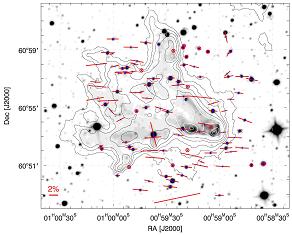
Mimir H-band polarization vectors overlaid on WISE 12um emission gray-scale image and WISE 25um emission contours. (From Andersson et al. 2013)
Boston University is a permanent partner/owner
in the Lowell Discovery Telescope
Mimir instrument, with outer cover and thermal shield removed. Picture taken during 2010 July warm servicing. The black box contains the four filter wheels and the three-camera block.
The globular cluster GC01, found in GLIMPSE images (Kobulnicky et al. 2005), imaged here with Mimir in the JHK bands. Left image is the full 10x10 arcmin field, center images shows a zoom of the central region. Right image taken with F/17 high-resolution camera option of Mimir, with pixel sampling of 0.18 arcsec.
Former Graduate Students: Dr. Emily Mercer (to Univ. Michigan), Dr. Michael D. Pavel (to UTexas - now MIT/Lincoln Labs), Dr. Sadia Hoq (to MIT/Lincoln Labs), Dr. Jordan Montgomery (to MIT/Lincoln Labs)
Former Undergraduate Students: Robert Marchwinski (to Penn State), Dr. Katie Jameson (to Univ. Maryland), Dr. Josh Shiode (to UC Berkeley), Sophia Kressy (U. North Carolina)
Mimir H-band polarizations (yellow and red vectors) surrounding the periphery of the L183 (=L134N) dark molecular cloud. Gray scale image is WISE 12um surface brightness decrement, which is related to dust column density. From Clemens (2012)
Mimir H-band polarizations in the Scorpius calibrator field (10x10' in extent), showing the primary polarization standards (solid vectors) and the new 'secondary' standards put forward in the GPIPS Calibration paper (Clemens et al. 2012b).
One 10x10 arcmin field in the Galactic Plane, from GPIPS. There are over 3,200 such fields making up the survey. (From theGPIPS First Data Release Paper)
